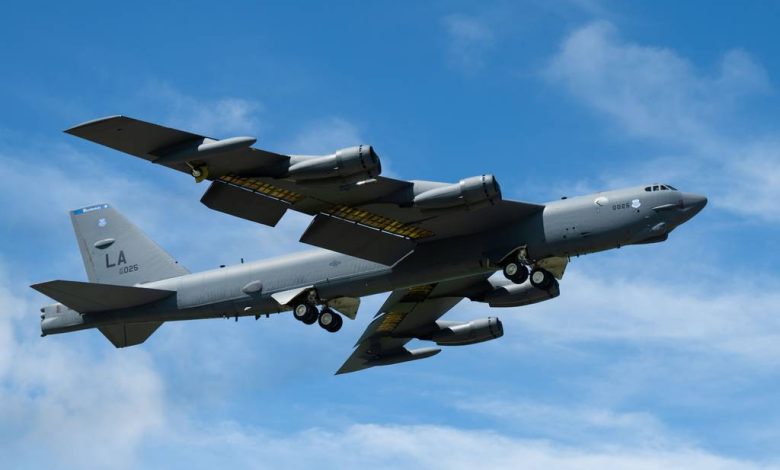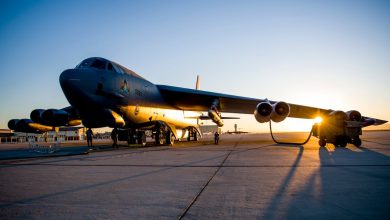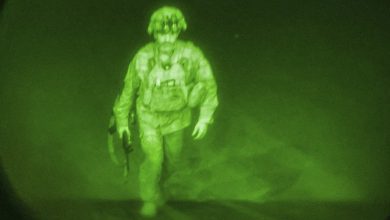Congress wants to restore nukes on conventional B-52 bombers

Congress is laying the groundwork to restore nuclear weapon capabilities on roughly 30 B-52H Stratofortress bombers that had been converted to drop only conventional munitions as part of the New START arms control treaty with Russia.
Both the Senate and House defense policy bills for fiscal 2025 would require the Air Force to once again make these conventional bombers part of the nuclear triad nearly a decade after removing those capabilities to comply with limits under the New START treaty. The current treaty is set to expire in February 2026.
Lawmakers are eager to beef up the U.S. nuclear arsenal given Russia’s suspension of the treaty and China’s rapidly expanding strategic warhead production. Opponents of the measure argue that the directives will make it more difficult to negotiate a new treaty while complicating efforts to significantly extend the lifespan of the B-52 bomber fleet first introduced during the Cold War.
“The treaty expires in 2026, and the prospect of Russia coming to the table for serious arms control discussions is incredibly unlikely,” House Armed Services Chairman Mike Rogers, R-Ala., said last week upon introducing the amendment to the FY25 defense policy bill, legislation the House passed 217-199 on Friday. “We need to be prepared to face a nuclear environment without any treaty limitations.”
The House bill would require the Air Force to begin reconverting the bombers within a month after the current treaty expires and complete the restoration of their nuclear capabilities by 2029. The House passed the B-52 amendment by voice vote over opposition from Rep. Adam Smith of Washington, the top Democrat on the Armed Services Committee.
“The Department of Defense is not interested in doing this,” said Smith. “What they’re interested in doing is investing in the B-21, which is the next generation nuclear-capable bomber. This would cost a great deal of money. Also, they’re currently trying to extend the life of a number of B-52s out to 2050, which they think they can do. This would be another added expense to that.”
The Senate Armed Services Committee voted 22-3 on Friday to advance its version of the bill with a similar provision directing the restoration of nuclear capabilities across the entire B-52 fleet.
The Air Force’s 76 B-52s are the oldest bombers in its fleet and have been flying since the early 1960s. During the Cold War, the Air Force flew nuclear-armed Stratofortresses along the edge of Soviet airspace.
Today, it remains one of the key elements of the U.S. nuclear triad, and is capable of carrying the AGM-86B air-launched cruise missile, or ALCM, nuclear weapon.
Not all B-52s have that capability. The Air Force in 2015 began removing nuclear capabilities from about 30 B-52Hs to comply with New START requirements.
The Senate ratified New START in 2010. The treaty limits both countries to 1,550 deployed warheads. Although Washington and Moscow agreed to extend the treaty for five years in 2021, Russia suspended its participation in New START in 2023 amid heightened tensions with NATO over its invasion of Ukraine.
Air Force Global Strike Command declined to comment about the potential restoration of nuclear capabilities to the rest of the B-52 fleet.
Mark Gunzinger, a former B-52 pilot and director of future concepts and capability assessments at the Mitchell Institute for Aerospace Studies, said that if it does happen, the reconversions would probably take place during depot maintenance at Tinker Air Force Base in Oklahoma, as the B-52 fleet receives top-to-bottom upgrades.
Later this decade, the Air Force will begin a sweeping overhaul of the B-52 fleet, giving the six-decade-old bombers new engines, radar, avionics, digital cockpit displays, wheels and brakes, and other improvements.
The modernization is so significant that the service plans to redub these bombers the B-52J. The service eventually plans to have a fleet of two bombers, with the B-52J flying alongside the new B-21 Raider once the Air Force retires the B-1 Lancer and B-2 Spirit.
Deployed warheads
President Joe Biden’s arms control adviser Pranay Vaddi told the annual Arms Control Association conference in Washington this month that the U.S. has reached out to Russia about negotiating a follow-on agreement to New START but that Moscow has been unwilling to engage.
He said the Biden administration does not currently plan to increase the number of deployed warheads, though those decisions would be contingent on Russian and Chinese actions ahead of New START’s expiration.
“The reasons for having an increase in your day-to-day deployed nuclear weapons has to be pretty compelling for a decision to be made to do that,” said Vaddi. “One of the main triggers for that or the latest indicators that we have to pay attention to is what the [People’s Republic of China] ends up doing.”
“Those are important considerations for us to bear in mind as we march toward February 1, 2026.”
The U.S. deploys some 1,770 strategic nuclear warheads while Russia deploys around 1,822, according to the Nuclear Threat Initiative. China currently has around 500 operational warheads and the Pentagon expects Beijing will reach 1,500 by 2035.
Daryl Kimball, the executive director of the Arms Control Association, argued the B-52 amendment and other measures in the defense bill could make negotiating a follow-up treaty with Russia more difficult.
“This provision as well as some other provisions that are in the bills that purpose steps to increase the number of deployed strategic nuclear weapons are extremely premature, counterproductive and – given the skyrocketing cost of the existing nuclear weapons modernization program – they’re cost prohibitive,” Kimball told Defense News. “Some members of Congress unnecessarily panic and are looking for ways to increase the US stockpile without a clear national security rationale.”
Another provision in the Senate defense policy bill from Sen. Deb Fischer of Nebraska, the top Republican on the Strategic Forces panel, would require a plan to develop an additional 50 Sentinel Intercontinental Ballistic Missiles on top of 400 ICBMs already deployed.
Gunzinger said that with Russia no longer adhering to the New START treaty, it makes sense to bolster the B-52 fleet’s nuclear capabilities given the potential threats the United States could face from China and Russia, as well as Iran and North Korea.
“We’re now facing a situation where there’s two nuclear peers,” Gunzinger told Defense News. “We have a nuclear triad that’s sized for a single nuclear peer, Russia.”
Gunzinger said the restoration could probably be done without much difficulty. The necessary wiring is probably still in place, he said, and physical components that had been removed could be re-installed.
“It’s doable, and that’s the beauty of maintaining bombers that can be re-equipped with the appropriate [nuclear weapons] components,” he said. “It’s a hedge against future uncertainty, and we are now in a future where it’s not one that we expected, even just a few short years ago.”
Bryant Harris is the Congress reporter for Defense News. He has covered U.S. foreign policy, national security, international affairs and politics in Washington since 2014. He has also written for Foreign Policy, Al-Monitor, Al Jazeera English and IPS News.
Stephen Losey is the air warfare reporter for Defense News. He previously covered leadership and personnel issues at Air Force Times, and the Pentagon, special operations and air warfare at Military.com. He has traveled to the Middle East to cover U.S. Air Force operations.







